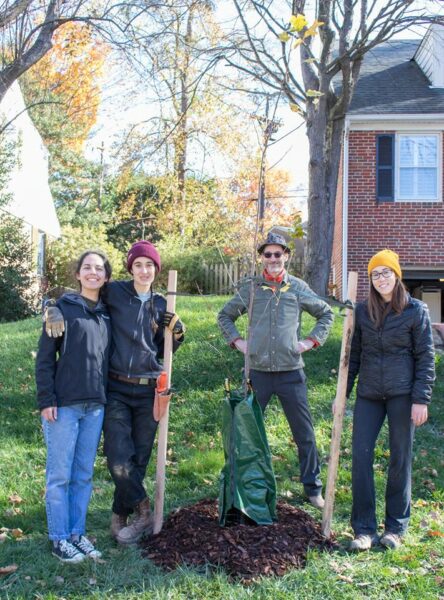By Carl Gold
I am kneeling in the soil using my hands to fill a hole. I am dirty and my back is stiff. My fingernails are cracked and my hands are callused and rough to the touch. I have not looked at my watch or cell phone for hours. I have spent the morning planting native trees. Planting a tree is like planting oxygen. Replanting trees in urban areas that have been denuded can heal heat islands, clean the air, filter water, reduce asthma, provide habitat and raise property values. Trees shade homes in the summer and serve as windbreaks in the winter. Trees absorb carbon and ultraviolet radiation. They are first line defenders against climate change.
Early spring and early fall are the best times to plant a tree. When a tree is planted it goes into shock- hot summer weather and drought add to this stress and can kill the tree before it has a chance to adapt. Similarly, freezing temperatures prevent root growth and a winter planted tree will struggle. If possible, plant a tree native to our region. Native trees bloom and leaf out timed to match the hatching of certain insects that rely on them for food. If those insects are not around migrating birds that feed on the insects will go elsewhere. A single mature oak tree can host over 500 species of nascent moths and butterflies – more than any other plant or tree. This is a wildlife smorgasbord. An oak may take 40-60 years to mature – but can live for centuries.
The planting hole should be 2-3 times as wide as the root ball. Start by removing any grass. Save it and set it aside. Make the sides of your circular hole perpendicular to the bottom- avoid slanted sides. The bottom of the hole should be flat so that water will not pool under the tree and tilt it. If your soil is severely compacted from development or construction, consider amending it with compost or better soil and increasing the width of the hole to give roots room to grow. Low-cost compost is available from Baltimore City’s Camp Small.
Cut away any wire and burlap or remove your new tree from the plastic pot. Now you must act ruthlessly and counterintuitively. If your tree grew in a plastic pot, it is highly likely that the roots are encircling the tree and if not addressed will ultimately girdle and kill the tree. Use a knife or your fingers to release the circling roots- it is ok to cut them to do this. If any of the roots have woody portions that are growing back towards the trunk- cut them off! They will never change direction so they must be removed to protect the tree from itself. Next, find the tree flare or first structural root- this is where the trunk widens at the base of the tree. It is likely to be covered with soil that you will have to remove. Planting depth is crucial. The tree flare must be visible just above the surface once you fill in the hole- it is better to be an inch too high than an inch too low- the tree will settle as you water it. The easiest way to make sure the depth is correct is to lay your shovel across the hole as you are back filling from the soil you set aside. The root flare should be level with the bottom of the shovel handle or slightly higher. If you are working solo, stop and check that the tree is centered and straight. Take the grass you removed, flip it over and create a berm around the tree. Cover with mulch making sure to leave the flare exposed. Think doughnut, not volcano.
From March to October, water your new tree at least weekly the equivalent of one to two inches of rainfall for the first two years. You might want to stake it to protect against lawnmowers and weedwhackers. If deer are a problem, you can wrap inexpensive fencing around the stakes to protect the tree. Depending on how bad the deer problem is you may need to keep the fencing for several years.
You have now given all of us a gift that will surpass anything you could do in your will.
Carl Gold is a Maryland Master Naturalist and a certified weed warrior and tree keeper. He can be reached at cgold@carlgoldlaw.com.

